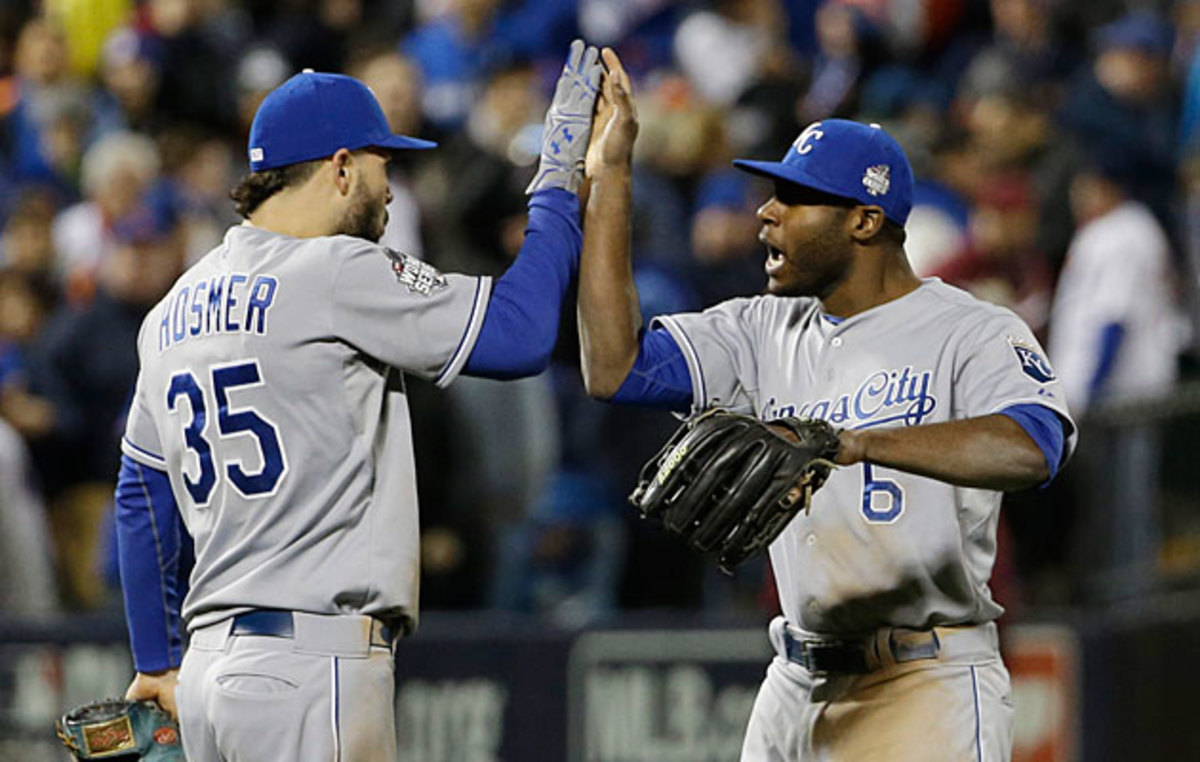Latest sequel cements Royals as greatest October comeback team ever

NEW YORK—To the list of successful movie franchises that includes Star Wars, Rocky, Indiana Jones and James Bond, you can add the Kansas City Royals. Okay, so the plots have become formulaic, there is no bona fide leading man, the chase scenes are repetitive and the endings are predictable, but you have to admit these guys are entertaining.
The Royals VI: Murphy’s Law, starring the usual ensemble cast, premiered at World Series Game 4 Saturday night. The climax began with the New York Mets five outs way from tying the World Series, only to have the Royals—stop me if you’ve heard this before—rally for victory behind a sudden spasm of hits, walks and errors that seemed so patently obvious. Those in attendance at the Citi Field screening groaned at the familiarity of the finish. The 5-3 win put Kansas City not only on the verge of its first world championship since 1985, but also close to cementing its reputation as one of the great rally teams of all time.
“What we do on offense,” Royals rightfielder Alex Rios said, “is organic. It is natural. I’ve been on other teams. This cannot be copied.”
Royals stun Mets in World Series Game 4, pull within one game of title
Kansas City has won six times this postseason after trailing by multiple runs, a record of serial comebacks that displaces the 1996 Yankees (five times) as the most prolific comeback team in baseball history.
The box set of victories now looks like this:
ALDS Game 2: Down Astros 4-1 in the third, won 5-4
ALDS Game 4: Down 6-2 in the eighth, won 9-6 (director’s cut edition).
ALDS Game 5: Down 2-0 in the fourth, won 7-2.
ALCS Game 2: Down 3-0 in the seventh, won 6-3.
World Series Game 1: Down 3-1 in the sixth, won 5-4 in 14 innings.
World Series Game 4: Down 3-1 in the sixth, won 5-3 (gift wrapped).
The Mets played the hapless foil with an overabundance of folly in the latest installment. Five outs from a 3-2 win and the bases empty, New York reliever Tyler Clippard walked Ben Zobrist. Mets manager Terry Collins had his closer, Jeurys Familia, warmed, but chose to leave the game in Clippard’s hands.
“We said before the inning, if the go-ahead run gets on, we're going to go to Familia,” Collins said. “But I didn’t want to have to burn Jeurys tonight for two innings, if I could help it. So it didn't work.”

The second biggest at-bat of the World Series happened next. (The biggest was the game-tying, ninth-inning home run by Alex Gordon off Familia in Royals V: The Shot in the Dark.) Facing Lorenzo Cain, Clippard jumped ahead 0-and-2 on two big swings from Cain.
“When he swings like that, falling back, I knew it was a good sign,” said Royals backup catcher Drew Butera. “I knew he was on everything from Clippard by those swings.”
Cain would force Clippard to throw six more pitches. Four of them were out of the strike zone. Clippard had just put the tying and go-ahead runs on base with walks—to a team that finished last in the league in walks. Really? Did that really happen? It was the cinematic equivalent to four teens deciding to walk down the darkened, creaking basement stairs of a deserted house out of naïve wonder of what could possibly be down there. You knew this was not going to end well for the Mets.

Collins brought in Familia to face Eric Hosmer. After one strike, Hosmer hit a weak, routine grounder toward second baseman Daniel Murphy. Once the ball bounced. Twice the ball bounced. And then the third bounce decided to be bashful—it was more of a skip than a bounce. This was the cue for another demonstration of the second law of thermodynamics.
Murphy reached down with his glove for the ball, but of course not far enough. You could almost see the baseball giggle as it passed beneath his glove, with hardly enough steam to make it to the outfield grass. Zobrist scored. Cain raced to third.
World Series title in sight for Royals after another trademark rally
“It’s a team that just looks for a little crack,” Royals manager Ned Yost said. “If we find a little crack, they’re going to make something happen. It’s amazing how they do that. And they do that in a number of ways. But the most important thing is they put the ball in play.”
The eighth inning of Game 4 was your routine Jenga game. Just one piece goes askew and the thing collapses on itself in sequential order. How many times have we seen it? Mike Moustakas lashed a single and then so did Salvador Perez. To recap, the game went from the Mets up 3-2 on their way to a series tie to Kansas City up 5-3 and one win from the championship in a five-batter sequence that went like this: walk, walk, error, single, single.
Now think about how the Royals scored the go-ahead run in their three wins in this series: a leadoff infield error that preceded a sacrifice fly in Game 1; a leadoff walk that preceded two singles in Game 2; and the walk-walk-error-single-single conga line of ridiculousness in Game 4.
• MORE MLB: Full postseason schedule, start times, TV listings
“I’ve never seen anything like this team,” Butera said. “It’s like a switch gets flipped and then—boom!—it just goes on.”
More prosaically, what Game 4's events proved again is that if you get deep enough into a series the flaws of a team will get exposed. The Mets came into the series worried about how the Royals’ contact-hitting approach would exploit the lack of athleticism and range in their infield. Errors by David Wright (Game 1) and Murphy figured in game-deciding rallies. And if games evolved into bullpen battles, New York was toast. The Kansas City bullpen out-mans every other bullpen.
After late Game 4 collapse, there’s plenty of blame to go around for Mets
The Royals have outscored opponents 44-11 after the sixth inning this postseason. Yost has become Ned Yoda with an uncanny knack for having nearly any decision of his, however goofy it may first appear, turn out wise. He is 21-9 in postseason games over the past two years, the best winning percentage for managers with at least 30 games in the playoffs.
His Royals are defined by these comebacks and how they have turned the game upside down in doing so. Starting pitching and power, two of the most expensive commodities in the game, hardly matter to how Kansas City wins. Consider this: The Royals have played .600 baseball over the past two postseasons (12-8) when their starter doesn’t make it through six innings. In normal baseball in the regular season, starts that short result in a .331 winning percentage. Short starts equal disaster, right? Not to Kansas City, which won on Saturday without a home run and with starting pitcher Chris Young lasting just four innings.
Collins’ pitching decisions (he also let rookie Steven Matz bat in the fifth, only to pull him two batters into his next time on the mound), Murphy’s glovework and Clippard’s command all deserve scrutiny. But let’s be realistic about what’s been going on here. The Royals help make their own luck and have turned “Keep the Line Moving” into their very own Battle Hymn of the Republic. The Mets just happened to be in their way right now.
#http://www.120sports.com/video/v156123232/royals-rally-past-mets
